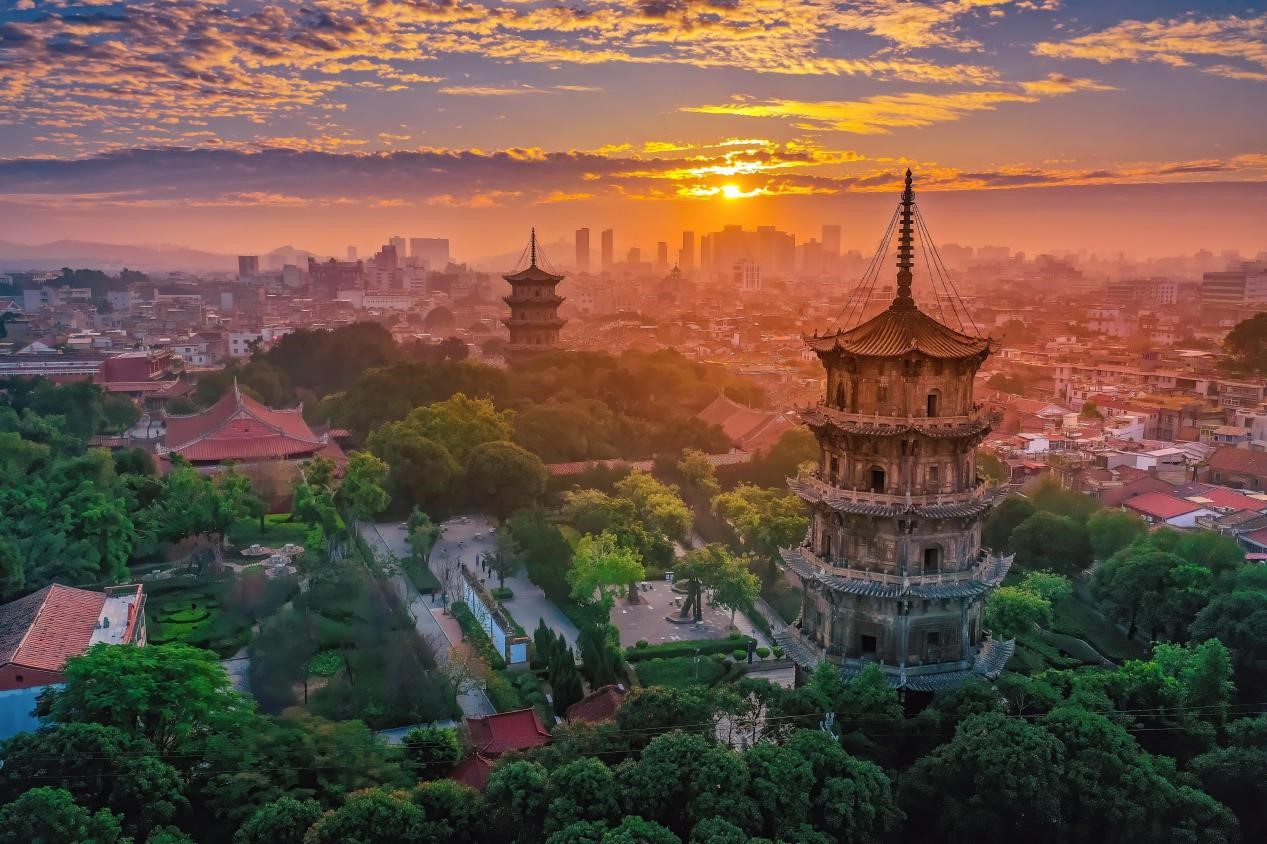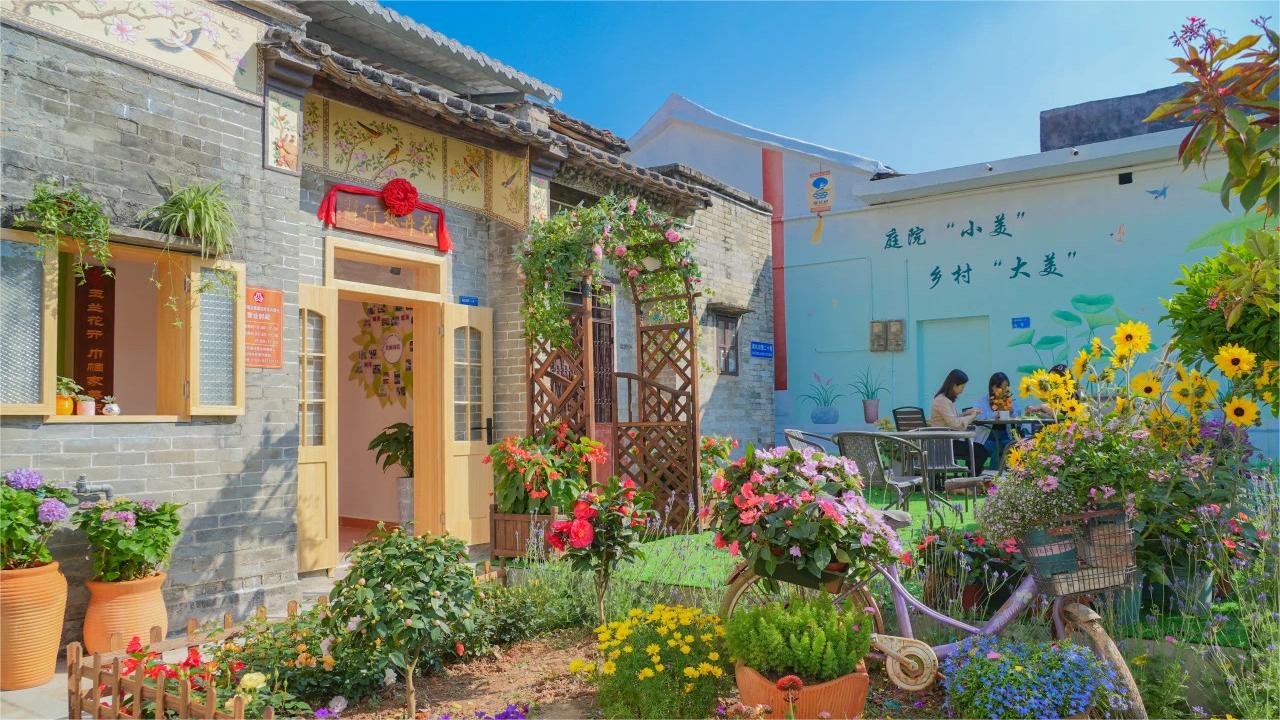Culture-tourism integration injects vitality into China's Quanzhou city, vital hub of Maritime Silk Road
Located in southeast China's Fujian province, Quanzhou is one of the most important Chinese ports along the historic Maritime Silk Road. "Quanzhou: Emporium of the World in Song-Yuan China" was added to the UNESCO World Heritage List on July 25, 2021, becoming China's 56th UNESCO World Heritage Site.
The serial property encompasses 22 sites of administrative buildings and structures, religious buildings, and statues, such as the Site of the Maritime Trade Office, the Confucius Temple, and the Kaiyuan Temple. They bear witness to the city's prosperous maritime trade and reflect its inclusiveness and commitment to opening up.

Tourists visit Zhongshan Road in Quanzhou, southeast China's Fujian province. (People's Daily Online/Zhang Jiuqiang)
Apart from the exceptional heritage preservation efforts, Quanzhou has been working on the deep integration of culture and tourism to maintain its historical features and revitalize its intangible cultural heritage.
In 2023, Quanzhou's tourism revenue surged 68.9 percent year on year to 100.24 billion yuan ($13.79 billion). The city welcomed nearly 86.53 million tourist visits home and abroad, a year-on-year increase of 53.9 percent.
At around 10:00 a.m., Jinyu alley, in Licheng District of Quanzhou, became bustling with life. The alley is named after "golden fish" in Chinese with its origin dating back to the Northern Song Dynasty (960-1127). It showcases the charm of the city's traditional architecture and epitomizes its cultural essence. At its entrance gathered groups of tourists, taking photos with the decorative golden fish patterns.
Just a short distance south of the alley is Zhongshan Road, which runs from north to south through Quanzhou. The road houses the well-preserved Qilou building complex, a quintessential architectural style in southern China. Strolling along the road, visitors can embrace a sense of leisure and relaxation.
Quanzhou is home to a number of Chinese ancient city gates, such as the Chaotian Gate, Quanshan Gate and Deji Gate, standing as silent witnesses to the city's profound history. The original signboards of many time-honored establishments also serve as nostalgic reminders of the city's bustling trade history.
In Quanzhou's Ancient City, located in Licheng District with a total area of 6.41 square kilometers, there are eight UNESCO World Heritage sites, including the Kaiyuan Temple, the Confucius Temple, and the site of the Southern Clan Office. The abundant historical relics, well-preserved ancient urban layout, and bustling crowds in the city all provide a captivating glimpse into its past prosperity and grandeur.
However, in the past, the Ancient City looked different from how it does now: cables were haphazardly installed between severely aged houses, and sewage would flow across the streets when it rained. As a result, many original inhabitants had moved away, and the once vibrant atmosphere of the city gradually faded away.

Photo shows the east and west pagodas of Kaiyuan Temple in Quanzhou, southeast China's Fujian province. (People's Daily Online/Wang Sheng)
In 2017, a renovation project kicked off in Quanzhou. Following the principle of exerting minimal impact on the daily lives of residents, the city adopted a series of science-based plans and management measures. The project mainly included upgrading the building facades, burying cables underground, paving roads, enhancing the city's night view, and integrating cultural elements into the landscape design. The extensive renovation has successfully brought back the charm of the Ancient City.
"Our goal is to protect not just the ancient buildings, but also the city's authentic way of life and its cultural heritage that has evolved and flourished over thousands of years," said He Zhenliang, head of the cultural heritage preservation and management office of the Confucius Temple, Quanzhou.
Puppetry was inscribed into the first batch of China's national intangible cultural heritage list as early as 2006. In recent years, a large number of young people have joined in the efforts to protect and inherit this art form, infusing it with fresh vitality.
According to Li Yunfeng, an inheritor of Quanzhou palm puppetry, another type of Quanzhou puppetry, young people in their thirties now make up the majority of the staff members at the palm puppetry art protection and inheritance center in Jinjiang city, Fujian province, which he works for.
"We perform more than 400 shows each year," said Li.
Puppetry is not the only traditional art in Quanzhou that has been passed down for generations.
As the sun set, people gradually took their seats at the Nanyin Pavilion, sipping tea and enjoying the melodious tunes. Every week, the pavilion holds four free performances.
Nanyin is one of China's oldest music styles and a UNESCO Intangible Cultural Heritage, often referred to as the "living fossil" in Chinese music history. It holds a special place in the hearts of Quanzhou locals, evoking nostalgic memories from their childhood.

The 7th China Quanzhou International Puppet Festival kicks off in Quanzhou, southeast China's Fujian province, December 9, 2023. (People's Daily Online/Huang Dongyi)
Currently, Quanzhou is home to six UNESCO Intangible Cultural Heritage elements, 36 intangible cultural heritage projects at China's national level, and 128 at China's provincial level, said He Yibin, deputy head of Quanzhou municipal culture, radio, television and tourism bureau.
According to He, Quanzhou has set up 12 museums of intangible cultural heritage, 166 venues for the inheritance of intangible cultural heritage, and 1,000 halls to demonstrate intangible cultural heritage. Besides, two training sessions for intangible cultural heritage inheritors are hosted each year to help them expand the market. Besides, the intangible cultural heritage has been made more accessible through training courses on short video shooting offered to inheritors. A special fund worth 10 million yuan has also been set up to support the development of intangible cultural heritage items, such as traditional operas and Nanyin.
Today, fascinating daytime tours and beautiful night views have become new features of Quanzhou's tourism.
In the evening, Zhongshan Road comes alive with captivating performances of martial arts, chest-slapping and acrobatic lion dances, offering an engaging experience for visitors. Art markets and music performances under old banyan trees make both locals and visitors slow down to take in the harmonious atmosphere. Puppet shows, Nanyin and traditional operas have all increased the frequency of nighttime performances.
"Quanzhou is currently working to provide a round-the-clock experience of cultural tourism. The city has become increasingly popular with the growing number of nighttime cultural and tourism consumption areas," said an official with Quanzhou municipal culture, radio, television and tourism bureau.
Photos
Related Stories
- In pics: Explore ancient Luoyang Bridge in Quanzhou, SE China's Fujian
- Overseas Chinese hailing from SE China's Quanzhou retain affinity to motherland
- Things to do in Quanzhou, UNESCO World Cultural Heritage city
- Eight must-see streets and lanes in Quanzhou, SE China's Fujian
- Soaking up Chinese New Year atmosphere in Quanzhou Ancient City
Copyright © 2024 People's Daily Online. All Rights Reserved.









